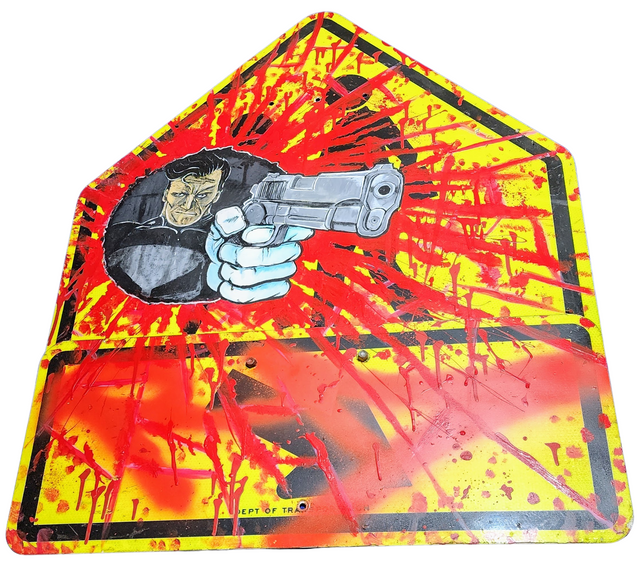
Street Signs
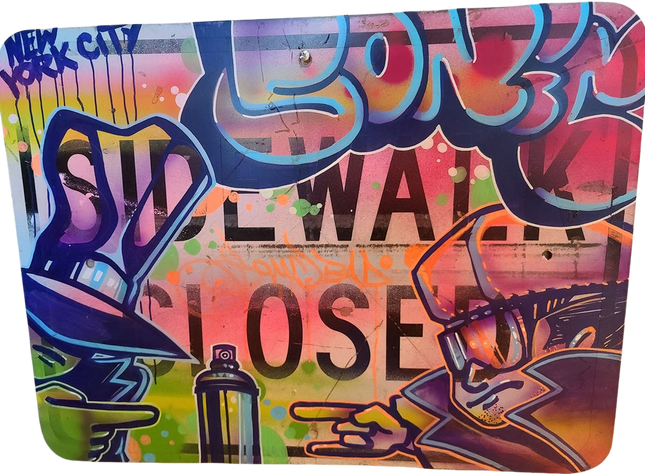
Sonic Bad Sidewalk Closed Original Mixed Media Street Sign Painting by Sonic Bad
Sidewalk Closed Original Mixed Media Graffiti Artist Modern Pop Art on Real Metal Street Sign by Sonic Bad. 2012 Signed Original Spray Paint & Metal Street Sign Artwork Size 24x18 Depicting 2 1970s-80s Stylized Beat Boys, NYC Graffiti Tags & Bubble Letters on Street Closed Sign Sonic Bad's Ode to the Streets: The 'Sidewalk Closed' Series The 'Sidewalk Closed' artwork by Sonic Bad, an original piece created in 2012, infuses the rebellious spirit of 1970s and 80s street culture into a medium that is emblematic of urban restriction: a real metal street sign. This mixed media work, signed by the artist, is a striking example of how street pop art and graffiti can repurpose public regulatory objects into canvases that challenge and reinterpret their original intent. Reclaiming Urban Symbols in Street Art Sonic Bad's choice of canvas—a metal street sign—turns an everyday symbol of control into a representation of creative liberation. The artwork, sized at 24x18 inches, is vibrant with color and life, presenting a stark contrast to the sign's mundane purpose of demarcating boundaries. By painting over it, Sonic Bad claims the object for art, much like graffiti artists claim walls for their tags and murals. The piece itself is a dynamic collage of NYC graffiti tags and bubble letters, styles deeply rooted in the history of street art. It showcases two stylized beat boys, figures that resonate with the hip-hop culture that was burgeoning on the streets of New York City during the 70s and 80s. These characters are not only representations of a specific era but also symbols of the energy and rhythm of street life. The Visual Language of Graffiti and Its Evolution Sonic Bad's work serves as a visual lexicon of graffiti's evolution, encapsulating the transition from tagging—often a raw, text-based expression of identity—to more complex and stylized works. The 'Sidewalk Closed' series is particularly evocative of this shift, highlighting the movement from simple letterforms to elaborate and colorful representations that are as much about the artistry of the line as they are about the message. The aerosol paint, a medium synonymous with graffiti, brings authenticity to the piece, its drips and opacity echoing the textures of street art seen in the wild. The metal sign, once reflective and directive, becomes muted and textured under layers of paint, a metaphor for the way street art can change the nature and conversation around public spaces and objects. Sonic Bad and the Living History of Street Art Sonic Bad's 'Sidewalk Closed' is more than a singular work; it is part of the living history of street pop art and graffiti artwork. It reflects a time when street culture began to permeate every aspect of urban life, from the music that played out of boomboxes to the art that adorned the walls and sidewalks of the city. This piece is a celebration of that era, a nod to the roots of street art, and a statement on its enduring influence. The artist, by merging nostalgia with contemporary expression, invites onlookers to explore the depth and breadth of street art. Through this work, Sonic Bad not only pays homage to the pioneers of the genre but also places himself within the continuum of artists who have utilized the street as their gallery. His legacy lies in his ability to transform the ordinary into the extraordinary, ensuring that the spirit of the streets remains vibrant and visible.
$2,000.00
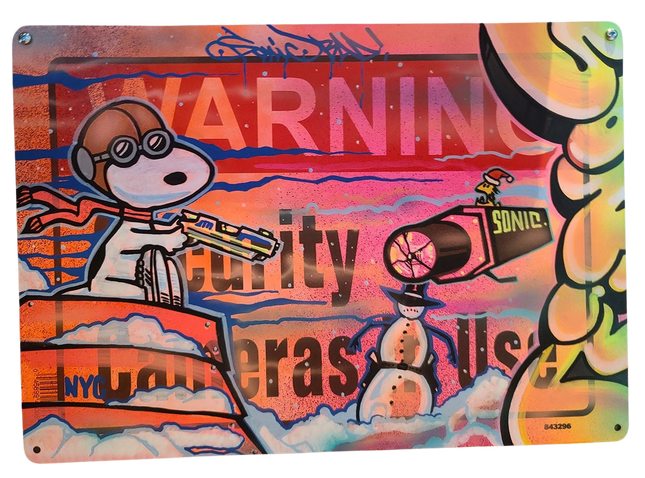
Sonic Bad Snoopy Bad Inc Original Mixed Media Street Sign Painting by Sonic Bad
Snoopy Bad INC is an original mixed-media graffiti artist—modern pop art on real metal street signs Sonic Bad. 2015 Signed Original Spray Paint Mixed Media on Tin Metal Security Sign. Sonic BAD INC Snoopy Bad INC Artwork Size 14x10 Depicting Peanuts Red Barron Snoopy & Woodstock Bomber Stylistic Graffiti Holding Pistol Gun with Security Camera and Snowman. Sonic Bad's Unique Blend of Iconography: Snoopy Bad INC Sonic Bad's "Snoopy Bad INC" is a striking work that marries the notion of classic comic characters with the gritty edge of street art, showcasing the artist's skill in blending pop culture references with a streetwise aesthetic. The 2015 piece is a mixed media work on tin metal, utilizing spray paint to bring vibrant life to an otherwise mundane security sign. Measuring 14x10 inches, this signed original work presents a version of the beloved Peanuts characters, Snoopy and Woodstock, reimagined as rebellious icons in a stylistic graffiti interpretation. Interpreting Street Narratives through Pop Culture Lenses Sonic Bad, an artist renowned for pushing the boundaries of street pop art, infuses "Snoopy Bad INC" with layers of meaning. By depicting the Red Baron Snoopy and a bomber, Woodstock holding a pistol gun, juxtaposed with a security camera and a snowman, the artwork comments on the surveillance state and the loss of innocence in contemporary society. The playful imagery contrasts with the underlying message about security, surveillance, and the militarization of everyday life. The transformation of familiar, comforting figures into agents of anarchy or resistance is a common theme in modern pop art and graffiti, where the recontextualization of well-known images challenges viewers' perceptions and expectations. Sonic Bad's portrayal invites reflection on how innocence and playfulness can be corrupted by societal control and violence. Crafting Commentary on Canvas and Metal The choice of a metal street sign as the canvas for "Snoopy Bad INC" is particularly resonant, suggesting a subversion of authority and a claim to the public space typically dictated by such signs. Sonic Bad's adaptation of the sign, a symbol designed to regulate and warn, into a piece of art underscores a reclaiming of agency, turning a tool of control into a medium for free expression. The use of mixed media in "Snoopy Bad INC" highlights Sonic Bad's versatility as an artist. Spray paint, a staple in graffiti art, brings an urban feel to the work. At the same time, incorporating other media adds texture and depth, creating a piece that is visually arresting and thought-provoking. The artwork stands as a testament to the power of street art to transform everyday objects and icons into profound statements. Sonic Bad's Artistic Evolution and Impact "Snoopy Bad INC" exemplifies Sonic Bad's evolution as an artist and his impact on street pop art and graffiti. His ability to weave together elements of popular culture, street art stylings, and social commentary places him among the leading figures in the genre, capable of sparking conversation and challenging societal norms. The piece is a vibrant addition to the discourse of street art, reflecting the genre's capacity to adapt and evolve. Sonic Bad's work, through pieces like "Snoopy Bad INC," continues to influence and inspire, ensuring the relevance and vitality of street pop art in a changing cultural landscape. The legacy of such art lies in its capacity to engage, provoke, and endure, much like the artist behind the creation.
$750.00
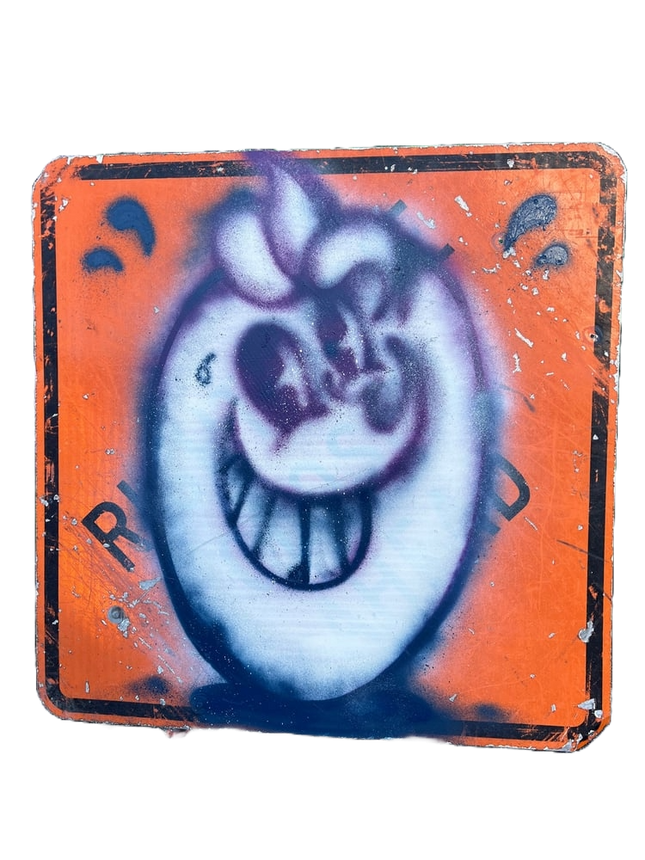
Atomik Lagos Original Street Sign Spray Painting by Atomik
Lagos Original Street Sign Spray Painting by Atomik Mixed Media Modern Graffiti Paint Pop Art on Real Metal Ready To Hang. 2023 Signed Original Painting on Reclaimed Metal City Road Construction Sign Artwork Size 36x36 of Spray Painted Smiling Atomik Orange In the vibrant world of modern graffiti and pop art, Atomik emerges as a unique voice, creating pieces that resonate deeply with art aficionados and street art enthusiasts alike. His 2023 artwork, titled "Lagos," is a prime example of his genius. Made on a reclaimed metal city road construction sign, this piece is not just a painting but a marriage of art and urban elements. Measuring 36x36 inches, "Lagos" is an ode to the urban environment from which Atomik draws inspiration. The centerpiece, the spray-painted smiling Atomik Orange, is instantly recognizable and evokes a sense of familiarity, bridging the gap between the street and the art gallery. The backdrop, a real metal city road construction sign, adds layers of authenticity and rawness to the piece. Its weathered appearance, marked with signs of wear and age, tells a story of its own, setting a contrasting stage for the vibrant and playful Atomik Orange. This painting does more than just showcase Atomik's technical prowess with a spray can. It challenges the boundaries of traditional art forms, blurring the lines between graffiti, pop art, and found object art. By choosing a reclaimed metal sign as his canvas, Atomik comments on the transient nature of urban life and the ever-evolving face of cities. For those who appreciate art that speaks to contemporary issues while staying rooted in traditional techniques, "Lagos" is a testament to Atomik's ability to capture the zeitgeist of modern urban culture. It's not just a piece of art; it's a conversation starter, a narrative, and a reflection of the times we live in.
$1,383.00
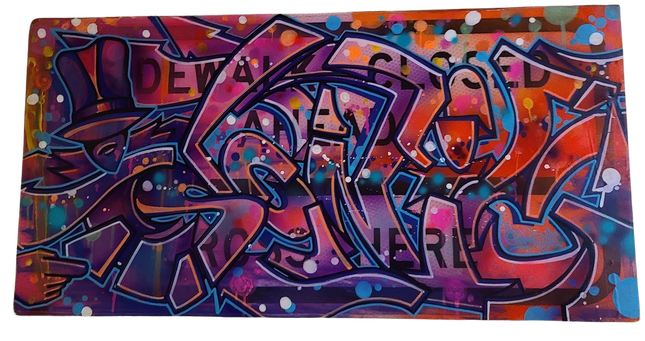
Sonic Bad Sidewalk Closed Wood Original Mixed Media Street Sign Painting by Sonic Bad
Sidewalk Closed- Wood Original Mixed Media Graffiti Artist Modern Pop Art on Real Street Sign by Sonic Bad. 2018 Signed Original Spray Paint & Mixed Media on Wooden New York City NYC Sidewalk Closed Vintage Sign Artwork Size 21.5x11.5 The Artistic Alchemy of Sonic Bad: Reimagining Public Notices Sonic Bad's 'Sidewalk Closed - Wood' is an exemplary showcase of modern pop art manifested through the lens of street sensibilities and graffiti culture. Created in 2018, this signed original piece is a vibrant declaration of the transformative power inherent in street pop art and graffiti artwork. The fusion of spray paint and mixed media on a wooden canvas that once served as a New York City sidewalk sign encapsulates the artist's penchant for repurposing the functional into the visually extraordinary. Technique and Symbolism in Sonic Bad's Work The artwork, measuring 21.5x11.5 inches, is a testament to Sonic Bad's mastery over mixed media. The piece harmoniously integrates the textures of wood with the fluidity of spray paint, achieving a layered effect that adds depth and complexity to the composition. The choice of a 'Sidewalk Closed' sign is significant; it takes an object that signifies obstruction and transforms it into a portal of creative expression, thus inviting reflection on the role of public space and the rules that govern it. Sonic Bad's approach to the sign is subversive yet playful, disrupting its original intent and engaging viewers in a dialogue about the accessibility of art and public communication. The vibrant color palette and intricate design work serve to capture the gaze and provoke thought, a hallmark of effective street pop art. The way the letterforms and characters are interwoven with the sign's warning embodies a kind of artistic alchemy, turning the mundane into the magical. Impact and Reception of Sonic Bad's Street Sign Artwork The 'Sidewalk Closed - Wood' piece by Sonic Bad does not simply occupy space; it commands attention and interaction. Its existence in a gallery or a private collection continues to challenge perceptions of street art's place within the art world hierarchy. Sonic Bad's work is celebrated for its unabashed embrace of street art aesthetics while simultaneously pushing the boundaries of what such art can communicate and how it is perceived. Sonic Bad, an artist who remains an enigmatic figure in the graffiti art scene, utilizes anonymity as a tool, allowing the work to speak for itself. The artist's contributions to street pop art are measured by the vibrancy of the pieces left in public view and the conversations they ignite. The influence of such work extends beyond the streets, infiltrating popular culture and challenging traditional art's status quo. Sonic Bad's Legacy in Street Pop Art Sonic Bad's 'Sidewalk Closed - Wood' is not merely a piece of reclaimed street furniture but a microcosm of street art's potential to redefine the aesthetics of urban living. This work stands as a cultural artifact, a piece of New York City's story told through the eyes of a street artist. Sonic Bad's legacy is enshrined in every color splash and line twist, a testament to the enduring allure and social commentary of street pop art and graffiti artwork. The legacy of artists like Sonic Bad is often measured by the endurance of their work in the public imagination and their ability to inspire future generations of artists. By turning a sidewalk sign into a canvas, Sonic Bad has not only altered the sign's trajectory but also contributed to the narrative of street art as a form of modern pop art. This piece will continue to be a point of reference for discussions about the interplay between public space and artistic freedom, embodying the spirit of street art that refuses to be sidelined.
$2,000.00
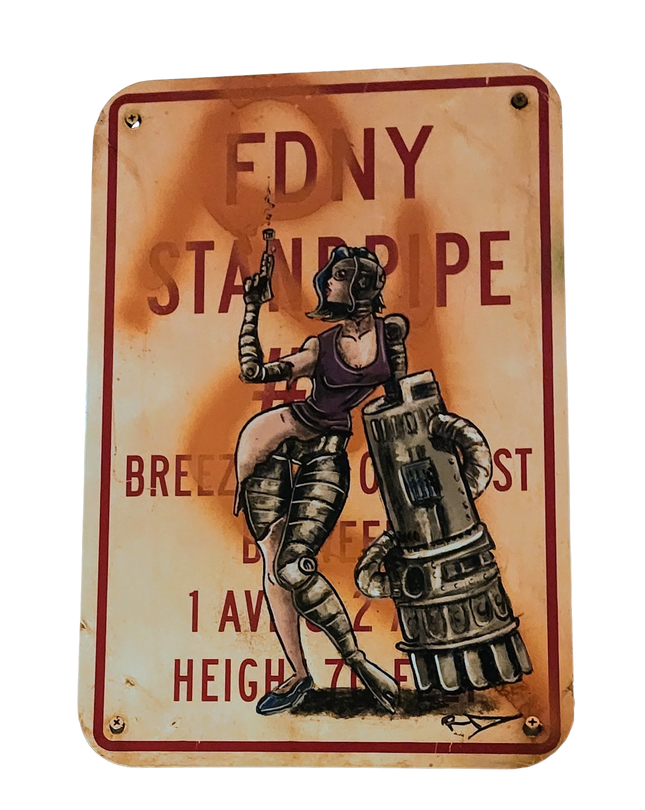
RD-357 Real Deal Techno Standpipe Original Street Sign Painting by RD-357 Real Deal
Techno Standpipe Original Street Sign Painting by RD-357 Real Deal Spray Paint Mixed Media is one of the kinds of artwork on New York City FDNY Standpipe Notice Sign Pop Graffiti Street Artwork. 2014 Signed Spray Painting Original Artwork on Real Reclaimed NYC Fire Fighter Metal Urban City Street Sign Size 13x18 Futuristic Sci-Fi Cyborg Robot Woman with Guns & Future Weapon Arm Replacement—RD Tag in Rust Red. RD-357's Techno Standpipe: A Metaphor of Futurism in Street Art The original Techno Standpipe street sign painting by RD-357, also known as Real Deal, is a compelling piece of street pop art that seamlessly blends technology and urban grit. Created in 2014, this work of art reimagines a New York City Fire Department standpipe notice sign as a backdrop for a dystopian narrative. The piece, signed by RD-357, features a futuristic sci-fi cyborg woman armed with advanced weaponry, conveying powerful themes of transformation and the intersection of humanity and technology. Symbolism and Significance in RD-357's Artwork In 'Techno Standpipe,' the cyborg woman symbolizes the evolving relationship between humans and machines. Her robotic arm replacement, depicted with meticulous detail, suggests enhancement and perhaps the loss of human elements, a theme that resonates deeply in an era where technology increasingly interfaces with every aspect of life. The choice of a standpipe sign, an emblem of safety and regulation, contrasts with the unrestrained and anarchic spirit of the cyborg, creating a visual paradox that challenges the viewer to consider the implications of technological advancement. The RD tag in rust red serves as the artist's signature and integration into the piece's aesthetic, echoing the rust and decay that often accompany urban infrastructure. This artwork, measuring 13x18 inches, uses spray paint to bring to life the textures and tones of metal and flesh, bridging the gap between the industrial and the organic. RD-357's Technique and Artistic Vision RD-357's execution of 'Techno Standpipe' demonstrates a masterful use of mixed media, combining the stark, flat surface of a metal sign with the depth and dynamism of spray paint. The artist employs shading, contouring, and color contrasts to give the cyborg figure a three-dimensional appearance, projecting her out of the sign's flatness and into the viewer's space. The shadows and highlights create a sense of movement, suggesting action and energy, symbolic of street pop art's dynamic nature. The artwork's gritty realism, underscored by the wear and tear on the sign itself, reflects the urban environment's influence on RD-357. Using a real street sign repurposes the found object and contextualizes the art within the living, breathing cityscape. This piece thus becomes a conversation between the artist, the medium, and the ever-changing urban landscape. The Cultural Resonance of 'Techno Standpipe' As a piece of street pop art and graffiti, 'Techno Standpipe' carries within it the pulse of contemporary culture, where concerns about the encroachment of technology into the human sphere are ever-present. RD-357 captures this zeitgeist, presenting a future vision that is both a warning and a wonder. The artwork invites introspection on the viewer's part, urging them to contemplate the direction in which society is headed. RD-357, whose real name and country of origin remain anonymous, maintains the tradition of street artists who operate under pseudonyms, preserving the mystery and rawness central to the genre. The 'Techno Standpipe' is a bold statement within RD-357's oeuvre, a one-of-a-kind piece that embodies the transformative and provocative power of street pop art and graffiti artwork. It is a visual manifesto of the times, a metallic cry from the city's heart that resonates with modern existence's complexities.
$600.00






